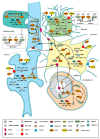Pathobiochemistry of Aging and Neurodegeneration: Deregulation of NAD+ Metabolism in Brain Cells
- PMID: 39766263
- PMCID: PMC11673498
- DOI: 10.3390/biom14121556
Pathobiochemistry of Aging and Neurodegeneration: Deregulation of NAD+ Metabolism in Brain Cells
Abstract
NAD+ plays a pivotal role in energy metabolism and adaptation to external stimuli and stressful conditions. A significant reduction in intracellular NAD+ levels is associated with aging and contributes to the development of chronic cardiovascular, neurodegenerative, and metabolic diseases. It is of particular importance to maintain optimal levels of NAD+ in cells with high energy consumption, particularly in the brain. Maintaining the tissue level of NAD+ with pharmacological tools has the potential to slow down the aging process, to prevent the development of age-related diseases. This review covers key aspects of NAD+ metabolism in terms of brain metabolic plasticity, including NAD+ biosynthesis and degradation in different types of brain cells, as well as its contribution to the development of neurodegeneration and aging, and highlights up-to-date approaches to modulate NAD+ levels in brain cells.
Keywords: NAD+; aging; brain; metabolism; neurodegeneration; nicotinamide adenine dinucleotide.
Conflict of interest statement
The authors declare no conflicts of interest.
Figures




Similar articles
-
NAD metabolism: Implications in aging and longevity.Ageing Res Rev. 2018 Nov;47:1-17. doi: 10.1016/j.arr.2018.05.006. Epub 2018 Jun 5. Ageing Res Rev. 2018. PMID: 29883761 Review.
-
Role of NAD+ in regulating cellular and metabolic signaling pathways.Mol Metab. 2021 Jul;49:101195. doi: 10.1016/j.molmet.2021.101195. Epub 2021 Feb 17. Mol Metab. 2021. PMID: 33609766 Free PMC article. Review.
-
Axonal energy metabolism, and the effects in aging and neurodegenerative diseases.Mol Neurodegener. 2023 Jul 20;18(1):49. doi: 10.1186/s13024-023-00634-3. Mol Neurodegener. 2023. PMID: 37475056 Free PMC article. Review.
-
NAD+ in Brain Aging and Neurodegenerative Disorders.Cell Metab. 2019 Oct 1;30(4):630-655. doi: 10.1016/j.cmet.2019.09.001. Cell Metab. 2019. PMID: 31577933 Free PMC article. Review.
-
NAD⁺ in aging, metabolism, and neurodegeneration.Science. 2015 Dec 4;350(6265):1208-13. doi: 10.1126/science.aac4854. Science. 2015. PMID: 26785480 Review.
References
-
- Yang S., Niou Z.-X., Enriquez A., LaMar J., Huang J.-Y., Ling K., Jafar-Nejad P., Gilley J., Coleman M.P., Tennessen J.M., et al. NMNAT2 Supports Vesicular Glycolysis via NAD Homeostasis to Fuel Fast Axonal Transport. Mol. Neurodegener. 2024;19:13. doi: 10.1186/s13024-023-00690-9. - DOI - PMC - PubMed
Publication types
MeSH terms
Substances
LinkOut - more resources
Full Text Sources
Medical

